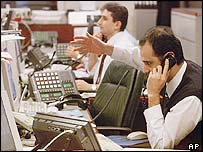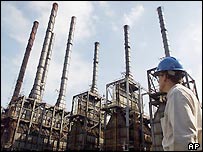|
By Alexander Koliandre
BBC Russian service
|


The stock market is growing, but ordinary Russians are wary
|
Russia's stock market started in earnest 10 years ago when the stock market index RTS was calculated for the first time.
The Russian school year traditionally starts on 1 September. In 1995 it was also the beginning of a new school for a handful of traders in the reforming post-communist country.
Russia's economy in 1995 was in many respects vastly different from what it has become today.
When the first RTS index was published - based on 13 companies and valued at 100 points - a lion's share of the country's industrial might was under state control.
Small oil companies and metals plants had been already privatised, but their shares were not traded openly.
Auctions of oil giants were not even considered at that time, while "corporate governance and financial transparency" sounded like some kind of a Martian language.
Foreign investment bankers and fund managers in their sleek suits were not yet perusing the hotel and restaurant prices in a faraway city of Moscow.
Boom and bust
Yet two years later the RTS became the fastest growing index in the world. In September 1997 the RTS index reached 500 points.
Every large investment bank was eager to set foot in Moscow.
But less than a year later the whole Russian economy crashed due to the unbearable weight of debts, cheap oil and the Asian financial crisis.
The RTS plunged to 38 points in a matter of weeks.
With high oil prices and political stability under the presidency of Vladimir Putin, Russia's market has recovered, although it took five years to climb back to 1997's level.
Today the RTS is on the rise again. There are more traders and investors on the Russian stock market than ever.

Oil shares are heavily weighted on the RTS index
|
It attracts so many foreigners that the volume of Russian shares traded in London exceeds the amount traded in Moscow.
After being almost ignored for a decade, shares in small companies are actively traded, as well as mining and metal producing companies, says Dmitri Tsaregorodtsev, a market analyst from Rye, Man & Gor Securities brokerage.
Just before its 10th anniversary, the RTS index rose to a record 880 points.
Ilya Efimchuk, a spokesman for the RTS stock exchange even predicts that in 25 years the RTS will reach the level of the US market.
'Dreaded capitalism'
But the RTS of today and the market of 1995 still have two crucial things in common.
 |
 The majority of the Russians regarded the RTS index as something bizarre and irrelevant for their everyday life
The majority of the Russians regarded the RTS index as something bizarre and irrelevant for their everyday life

|
Firstly it remains oil-dominated. Fewer than a dozen oil companies account for almost 50% of the index. This is unsurprising, as oil and gas revenues constitute about 40% of the state's budget.
This makes the whole market dependent on oil prices and the fate of a handful of domestic oil companies.
Secondly, the stock market in Russia remains an institutional investors' playground.
During Soviet times, stocks and shares were the epitome of the dreaded capitalism. The majority of Russians still regard the RTS index as something bizarre and irrelevant for their everyday life.
Trading shares and investing in stocks is still far from being popular. The total number of domestic private investors in Russian shares is about 50,000, less than 0.05% of the country's population.
The average Russian who has some money to put aside still prefers to stock it under the mattress rather than plunge into the volatile world of the stock market.
Russian might be attracted by the current growth, but they also remember the crash of 1998. It might take another decade for Russians to start trusting stocks and shares.

~RS~q~RS~~RS~z~RS~10~RS~)